“Have you ever wondered about the ways to prevent falls among older adults? While falls and related injuries are increasing among the senior population, there’s good news. These incidents, which pose a risk to their health and independence, are preventable. You can step up to safeguard your older loved ones or prepare for your future by understanding the potential risks and employing proven methods to avoid falls.
Why don’t we start unraveling the ways to mitigate these accidents?

Proven Ways to Reduce Falls in the Older Population
There’s no debate that falls are a serious threat to the health of older adults. With the rising numbers of older adults (anyone 65 years and older), the risk of falls increases as well. In 2020 alone, falls among adults 65 and older caused over 36,000 deaths, making it the leading cause of injury deaths among this age group. However, it’s comforting to know that those falls are not inevitable. You can take several steps to reduce the probability of such incidents.
Understanding the Causes of Falls
Before we delve into the methods of preventing falls, let’s first understand what primarily causes them. Medicines or health conditions can affect a person’s balance, making them more susceptible to falls. Similarly, environmental factors like poor lighting, uneven surfaces, or clutter can also become hazards leading to falls.
Implement a Personal Mobility Plan
Create a personalized mobility plan which includes exercises to improve balance, strength, and flexibility that can aid in reducing falls. Make sure to include important elements like regular vision tests to adjust any visual aids as required, adequate footwear, home safety modifications, and regular doctor consultations to review medicines potential side effects.
Detailed Assessment and Tailored Interventions
Every person is unique and so are their health conditions. A detailed assessment helps to identify a person’s particular risk factors – this could include a review of their medication, history of falls, physical mobility and balance, vision checks, and their home environment. The resulting intervention should be tailored to their needs.
CDC’s Role in Fall Prevention
The Centers for Disease Control and Prevention (CDC) has a significant role to play in preventing falls. This includes collection and analysis of data to better understand these incidents and develop effective preventive strategies. They offer a range of resources such as articles, educational materials, and training guides to aid in this cause.
Building Awareness and Offering Resources
The CDC offers valuable resources to build awareness about fall prevention. Their “Keep on Your Feet” feature article on older adult falls is a worthwhile read. They also provide an extensive mobility plan for older adults to ensure their wellbeing.
Contribution to Safety Research
CDC contributes significantly to fall safety research. They present their findings in various articles and reports which throw light on trends, causes, and methods to prevent such accidents. An example of this is their report on “Trends in Nonfatal Falls and Fall-related Injuries Among Adults Aged ≥65 Years.”

The Significant Economic Impact of Falls
It’s not just the health impacts, but the economic implications of falls among older adults are hefty too. As per the CDC data, these falls cost around $50 billion in medical costs yearly, with 75% of these expenses borne by Medicare and Medicaid.
Communication is key
Stay connected with CDC through their email updates to keep abreast of the latest findings and solutions related to older adult falls. Their work extends beyond just research and data analysis. They are committed to saving lives and protecting people. They even offer contact details for any queries or help you might need.
Ensuring the safety of older adults is a shared responsibility. While individuals need to take precautions and remain aware, organizations such as the CDC play a significant role in carrying out research, suggesting interventions, building awareness, and providing resources. Remember, falls don’t have to be an inevitable part of aging. With the right effort, falls can be avoided, and lives can be saved.
Remember to follow this space for more informative articles on health and safety. Let’s work together in making the world a safer place for our seniors.”

